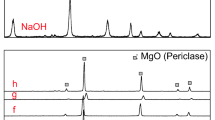Abstract
High purity MgO is widely used in various fields as an important magnesium compound. The separation of Mg and Ca is of great importance for the preparation of high purity MgO from dolomite. In this study, the key effects of carbonization temperature and nano-calcium carbonate agglomeration on the separation mechanism of calcium and magnesium have been investigated. The results indicated that the reaction in the carbonization process was stepwise. Precise control of the carbonization temperature was essential for the formation of Mg(HCO3)2 due to its low reaction efficiency at lower temperatures or decomposition markedly at higher temperatures. Meanwhile, there was a common-ion effect in solutions containing Mg2+ and Ca2+. Nano-CaCO3 particles were formed during carbonization and agglomerated with the prolongation of static time. A product with a purity of 99.56% MgO and 0.16% CaO was obtained under the optimized conditions: ratio of liquid–solid 30 L/g, carbonization temperature 22–25 °C, carbonization time 1 h, and refining time 4 h. This work has important guiding significance for the preparation of high purity magnesium oxide from dolomite.













Similar content being viewed by others
References
Luo BJ et al (2014) Progress of high purity magnesium oxide preparation. Appl Mech Mater 525:62–65
Chen M et al (2017) Densification and grain growth behaviour of high-purity MgO ceramics by hot-pressing. Ceram Int 43(2):1775–1780
Liu Y et al (2012) Method for producing high-purity MgO with light-burned powder as raw material. Shenyang University of Chemical Technology, Peop. Rep. China, p 6
Amer AM (1996) A contribution to hydrometallurgical processing of low-grade Egyptian dolomite deposits. Hydrometallurgy 42(3):345–356
Alamdari A et al (2008) Kinetics of magnesium hydroxide precipitation from sea bittern. Chem Eng Process 47(2):215–221
Kim MJ, Cho TY (2018) Method for recovering magnesium from seawater and a magnesium compound. Korea Maritime and Ocean University, S. Korea, p 23
Nativ P, Birnhack L, Lahav O (2016) DiaNanofiltration-based method for inexpensive and selective separation of Mg2+ and Ca2+ ions from seawater, for improving the quality of soft and desalinated waters. Sep Purif Technol 166:83–91
Tran KT et al (2013) Recovery of magnesium from Uyuni Salar brine as high purity magnesium oxalate. Hydrometallurgy 138:93–99
Dave RH, Ghosh PK (2005) Enrichment of bromine in sea-bittern with recovery of other marine chemicals. Ind Eng Chem Res 44(9):2903–2907
柴多里,储志兵,杨保俊,张柠.工业硫酸镁制备高纯氧化镁的合成研究广州化工, 2009,37(03):80–83
Wang J et al (2015) Thermodynamic and kinetic studies of the MgCl2-NH4Cl-NH3-H2O system for the production of high purity MgO from calcined low-grade magnesite. AICHE J 61(6):1933–1946
Virolainen S et al (2016) Removal of calcium and magnesium from lithium brine concentrate via continuous counter-current solvent extraction. Hydrometallurgy 162:9–15
Najmr S et al (1979) Chemical processing of magnesite to pure magnesia. Czech, p 4
Li Z, Wang J (2012) Method for producing high-purity magnesia from low-grade Mg-containing ore. Institute of Process Engineering, Chinese Academy of Sciences, Peop. Rep. China, p 8
Ding Y et al (2001) Nanoscale magnesium hydroxide and magnesium oxide powders: control over size, shape, and structure via hydrothermal synthesis. Chem Mater 13(2):435–440
Sheila D, Sankaran C, Khangaonkar PR (1991) Studies on the extraction of magnesia from low grade magnesites by carbon dioxide pressure leaching of hydrated magnesia. Miner Eng 4(1):79–88
Nduagu E et al (2012) Production of magnesium hydroxide from magnesium silicate for the purpose of CO2 mineralisation. Part 1. Application to Finnish serpentinite. Miner Eng 30:75–86
Fedoročková A, Raschman P (2008) Effects of pH and acid anions on the dissolution kinetics of MgO. Chem Eng J 143(1–3):265–272
Davis NE et al (2011) Grain growth kinetics of dolomite, magnesite and calcite: a comparative study. Phys Chem Miner 38(2):123–138
Yildirim M, Akarsu H (2011) Preparation of magnesium oxide (MgO) from dolomite by leach-precipitation-pyrohydrolysis process. Physicochem Problems Min Proces 44:257–272
Hipedinger NE, Tedesco PH (1988) Recovery of high-purity calcium and magnesium compounds from Argentine dolomites. Revista de Metalurgia (Madrid, Spain) 24(2):77–83
Akarsu H, Yildirim M (2008) Leaching rates of Icel-Yavca dolomite in hydrochloric acid solution. Miner Process Extr Metall Rev 29(1):42–56
Karidakis T, Agatzini-Leonardou S, Neou-Syngouna P (2005) Removal of magnesium from nickel laterite leach liquors by chemical precipitation using calcium hydroxide and the potential use of the precipitate as a filler material. Hydrometallurgy 76(1–2):105–114
Vostrikova AV et al (2018) Thermal carbonization in nanoscale reactors: controlled formation of carbon nanodots inside porous CaCO3 microparticles. Sci Rep 8(1):1–7
Smith WR (1996) HSC Chemistry for Windows 2.0. J Chem Inf Model 36(1):151–152
Carmi I, Kronfeld J, Moinester M (2019) Sequestration of atmospheric carbon dioxide as inorganic carbon in the unsaturated zone under semi-arid forests. Catena 173:93–98
Shimpi N, Mali A, Hansora DP et al (2015) Synthesis and surface modification of calcium carbonate nanoparticles using ultrasound cavitation technique. Nanosci Nanoeng 3(1):8–12
Acknowledgements
This research was supported by the National Natural Science Foundation of China (No. 21776320) and Hunan Provincial Natural Science Foundation of China (No. 2018JJ2489, No.2018JJ2484), the Hunan Provincial Science and Technology Plan Project (No. 2016TP1007).
Author information
Authors and Affiliations
Corresponding authors
Additional information
Publisher’s Note
Springer Nature remains neutral with regard to jurisdictional claims in published maps and institutional affiliations.
Sihua Lei and Yu Gan are co-first authors
Rights and permissions
About this article
Cite this article
Lei, S., Gan, Y., Cao, Z. et al. The preparation of high purity MgO and precision separation mechanism of Mg and Ca from dolomite. Mining, Metallurgy & Exploration 37, 1221–1230 (2020). https://doi.org/10.1007/s42461-020-00213-w
Received:
Accepted:
Published:
Issue Date:
DOI: https://doi.org/10.1007/s42461-020-00213-w




